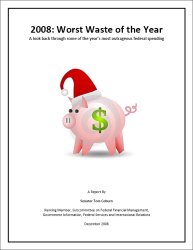 U.S. Senator Tom Coburn, M.D., Republican from Oklahoma, recently released a report entitled “2008: Worst Waste of the Year,” which highlights “absurd federal spending from beltway bureaucrats and elected officials.”
U.S. Senator Tom Coburn, M.D., Republican from Oklahoma, recently released a report entitled “2008: Worst Waste of the Year,” which highlights “absurd federal spending from beltway bureaucrats and elected officials.”
Here’s an excerpt from the report:
Some examples of Washington waste are well-intentioned, but raise questions about whether certain projects are best left to local government or private financiers. The Wilson Skateboard park for youth in the suburbs of Los Angeles is one such example, which received nearly $300,000 in federal grants this past year. Another is the free-bike library in one Colorado town, which allows local residents to check out bikes at no cost – it received $66,000 in 2008.
Fort Collins, Colorado received the federal grant to promote clean air, which it used to start the Fort Collins Bike Library, which allows residents, students, and visitors to Fort Collins to borrow check out bicycles for free for up to five days. Since it opened in April of this year, more than 1,700 different people have checked out a bike, reducing vehicle trips by an estimated 15,958 miles, and keeping 7.3 metric tons of carbon dioxide out of the air because people are using the bikes instead of cars. The Bike Library has proven so popular that a major expansion is planned for 2009.
In addition to the Fort Collins Bike Library, the report also calls out several other bicycle related projects for rebuke — bike paths in Baton Rouge, Louisiana, Share The Road signs in Southampton, New York, and the Freewheel Midtown Bike Center in Minneapolis, Minnesota, which provides the community a full-service bike transportation station, complete with long/short term Bike Storage, Bike Rentals, a Cafe , Repair Classes and a Shop where the public can do their own bike maintenance.
As a physician, you would expect Senator Coburn to recognize the value of bicycling in improving and maintaining public health. And as a Senator, you would expect him to recognize the value of bicycling in reducing our nation’s dependence on oil, reducing air and noise pollution, reducing traffic congestion, and improving roadway safely.
But apparently not.
(Incidentally, Coburn apparently didn’t waste any money paying for the clip art he uses in his report. The image on the front cover — a piggy bank wearing a santa hat — was stolen from Dreamstime. The watermark (the swirl in the center) indicates that the image was lifted right off the Dreamstime web site, and has not been paid for, even though it only costs $1 to properly license the image.)
Read more from The Coloradoan, BikeHacks.com.



[…] on the network today, a post from Kansas about an Oklahoma senator who seems to have a problem with bicycles, an update on the […]
The best part of Coburn’s report is where he summarized the $800 million transportation bill.
In 2008, more than $800 million in taxpayer funds were spent on “transportation enhancement”
(TE) projects, such as bike paths, pedestrian facilities, museums, scenic routes, historic
preservation, and greenery for roadside beautification.196 To pay for these frivolous projects,
taxpayer dollars are siphoned from federal highway transportation dollars needed for critical
infrastructure initiatives, such as road and bridge repairs.
I think Coburn should talk to some of the cyclists and pedestrians who use the paths to get to work–and tell them that their means of commute is frivolous.
[…] out by men who didn’t appreciate me ignoring their advances. Also on the network today, a post from Kansas about an Oklahoma senator who seems to have a problem with bicycles, an update on the […]
The Baltimore-Washington Parkway is an example of a “scenic route”. It’s one of the more popular ways for Residents of Washington, DC to get to Baltimore, and vise-versa (besides the MARC Train, which doesn’t even run on weekends). Right, who needs that?
And what kind of person calls a museum frivolous?
What now walking is frivolous too?
What’s next, breathing?
The whole point of greenery for roadside beautification is that it saves the state money and looks better at the same time – which would appear to be a win-win situation. If you spray wildflower seeds on the roadside you can let it grow wild all summer and nobody will complain, as compared to a grass which has to be mowed by a work crew all the time – which costs a lot more. Plus native species are given a boost. And it’s pretty.
Coburn put the Federal Highway Administration’s entire “transportation enhancement” (TE) program on his list as well. This $800 million program (in 2008) has been the source of most of the bike lanes, bike paths and many of the sidewalks in the nation since 1991 thanks to far-sighted members of congress who funded the enhancement program to the tune of about 4% of all federal highway monies. Thanks to them also for the Congestion Mitigation and Air Quality (CMAQ) program which funded the Fort Collins Bike Library, our Bicycle Coordinator, and many of the bike paths in town. These programs and the hard work of City transportation planners, in large part, have made Fort Collins a Gold Level Bicycle Friendly Community, according to the League of American Bicyclists, and have made Fort Collins one of the best places to live and to locate a business in the country, according to Money Magazine. Oklahoma hasn’t a single bicycle friendly community compared to eight in Colorado.
For Coburn’s 2009 list we’re working on using library bikes to offer escorted rides for kids, seniors and visitors from Oklahoma who otherwise might not bicycle.